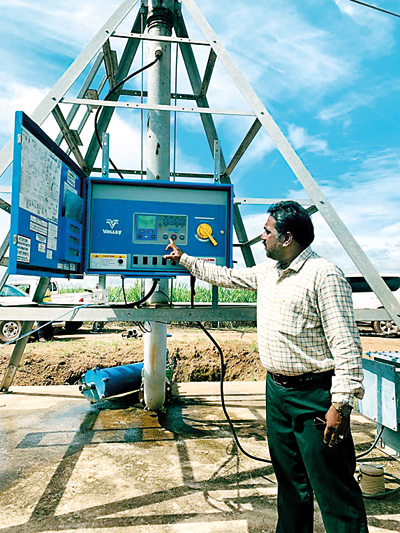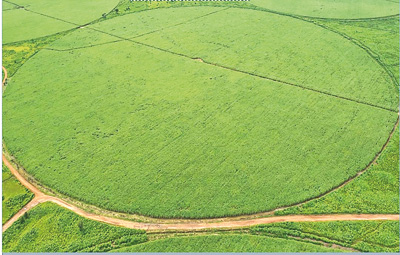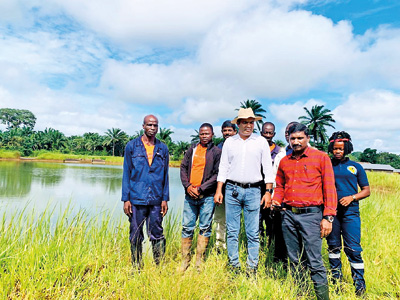Browns’ Sunbird leads African entry through Sierra Leone
Sierra Leone – The notion that ‘success at home breeds success abroad’ is a tenet that Sri Lanka’s Browns Investments PLC goes by.

M. Naguleswaram, Manager Irrigation at Sunbird Bioenergy explaining how one of the automated pivots works.
Last year they, already owning the local Hingurana sugar factory, characterised this by buying control of a bio-fuel producing sugar farm in the West African coastal state of Sierra Leone which is one of the largest sugarcane agricultural projects in the African continent.
They acquired a majority stake of Sunbird Bioenergy Limited which holds not only this plantation with the perennial true grasses in the region of Makeni, in Northern Sierra Leone but also a 32 Mega Watt (MW) Biomass renewable energy power plant. Makeni is the largest city in the Northern Province of Sierra Leone, the capital of Bombali District and the economic centre of the Northern Province. It is the fifth largest city in Sierra Leone by population.
This company, now called Sunbird Bioenergy (SL) Ltd has 23,500 hectares (Ha) for sugarcane production and a factory with a production capacity of 85 million litres of bio-fuel per annum.
At the plantation that I visited, long and dense stretches of sugarcane that are cultivated on miles of land hits you with a spectacular backdrop gasping once in a while behind turquoise coloured rivers.
Sierra Leone’s temperate climate, beautiful sunshine, gentle trade winds and cooling rains have been crucial factors in creating the perfect conditions for growing sugar, Subhash Abeywickrama, Chief Operating officer (COO)/Director Sunbird Bioenergy (SL) Ltd said walking towards a section of the plantation at sunrise on a cool Tuesday. The trails to the plantation were crooked, winding, lonesome, and leading to the most amazing views. The mountains rise into and above the clouds.
SL similarities
But this was not such a rosy picture two years ago when the former owners declared “force majeure,” scaling down the project when Ebola hit Sierra Leone and was looking for buyers to sell a stake in it. Browns, seeing potential, took up the challenge.
Apparently, there are quite a few similarities between Sierra Leone and Sri Lanka.
For instance, both have SL as an acronym. Sierra Leone was formerly known as Selone while we were Ceylon. Both countries are situated 7 degrees north of the equator line. Both countries were British colonies and both had civil wars. Lastly, Sierra Leone means Lion Mountain whereas Sri Lanka has the lion on its National Flag, Mr. Abeywickrema said noting the parallels.
The direction for investment by Browns was also due to the fact that the country has a large scale requirement for sugar. Sunbird Bioenergy with the world's largest Biomass to power generation project with a project value of above US$ 550 millions has the capacity to electrify 25 per cent of Sierra Leone’s requirement in electricity.
“In this part of the world, considering the soil’s potential, labour productivity and other social economic factors, to breakeven, we need 55 yield – which is the number of sugarcane tonnage for a hectare,” he said. This figure is arrived at by considering costing, the burn rate which is the monthly expenditure etc. In the past, it was a struggle to get at least 50 yield, Mr. Abeywickrama said.
The main reasons for the previous owners to not succeed, apart from the Ebola outbreak in May 2014 which took a terrible toll on the nation and this project (which saw increasing costs, delaying development etc) he said are that their plantation strategy was wrong. “Planting requires patient labour and attention. Plants do not grow merely to satisfy ambitions or to fulfill good intentions. They thrive because someone expended effort on them,” he noted showing a large, robust sugarcane leaf.
He said that some sugarcane varieties which had done well in other parts of the world such as in South Africa were brought here during the past management. “For an example, the Nattal variety of sugarcane which was planted earlier, does well in Nattal, South Africa. It doesn’t do well in Sierra Leone. So we selected location specific varieties to be harvested at this facility.”

View from a drone of the sugar cane plantation.
Senthil Kumar Nalliah, CEO Sunbird Bioenergy added that since Sri Lanka, Sierra Leone and India are 7° north of the equator, sugarcane varieties in Sri Lanka and in Coimbatore, India were suitable to be planted in Makeni. He said that five different varieties were developed and they realised that these were doing well in terms of yield, quality and sugar content.
He also noted that the rainfall patterns in other parts of the world are on average 700 mm to 2,500 mm but in Sierra Leone its some 2,800 mm which is the average over the last five years. So in the three months of rain – June, July and August – the water stagnation was hindering sugarcane growth. “So we corrected the drainages and opened new canals during these months,” Mr. Abeywickrema explained. He said that the company deployed drones to check the contour maps and see where the water stagnation was in order to direct the water towards the river.
Also the company started monitoring the irrigation calendar which wasn’t done previously. It has a mechanised irrigation system with pivots running into nearly half a kilometer in radius.
Next, the acidity of the soil was high in 60 per cent of the land and it was less than pH5. “We imported dolomite and deployed it before planting the sugarcane to increase the pH levels of the site,” Mr. Abeywickrema added. He noted that 92 tonnes of seed cane from a hectare was planted just in six months of planting.
Precision
M. Naguleswaram, Manager Irrigation at Sunbird Bioenergy joined in the discussion noting that spacing of the plants changed from the previous time. “So density of plants was more. Also micromanagement of practices started and ghost labour was eradicated,” he said walking into the spacings of sugarcane rows.
Mr. Abeywickrema stressed that with these practices, the company gives real meaning to ‘precision agriculture’.
A. Anandan, Head of Agriculture Sunbird Bioenergy chipped in, noting that the team is confident this year they can average a yield of 100 tonnes per hectare and said that motivating the workers was easy after the new management came.
In pockets of gatherings, men and women (some with little babies strapped to their backs) were working. Most had hands in the dirt, heads in the sun, but one can tell – their hearts with nature. Mr. Abeywickrema added that it was truly a task to make a mental shift with the workers. It was important to drive into them that to nurture this plantation is to feed not just on the body or a family, but the souls as well, he added. The company which is the only Sri Lankan firm with such a large scale project in West Africa has increased its staff to 4,500 from the earlier 1,800.
G. N. Thiruselvam, Agronomist at Sunbird Bioenergy noted that the company practised single bud planting which saved 6 to 8 tonnes of seed material. “It’s called vegetative propagation. Initially it takes a longer growth recovery in the first two months. Later it grows in a better manner and the tillers are robust and more in numbers as well as the cane weight is higher,” he explained.

Subash Abeywickrama, Chief Operating Officer (COO)/Director Sunbird Bioenergy (SL) Ltd with workers at the site.
He said now they have harvested 13,500 acres of sugarcane and 12,000 acres will be planted next month which the season starts from.
Mr. Abeywickrema noted that after planting 4,500 Ha in the current season they will get 750,000 tonnes of cane. The target is 1 million tonnes of cane from 12,000 Ha or 29,000 acres. “So we are going for vertical integration while adopting Good Agricultural Practices (GAP),” Mr. Abeywickrama said beaming that from 11,000 acres planted in less than one season is the highest extent of sugar cane planted in the entire African continent.
He is confident that in the next season – by next year November, 2,000 Ha or 4,900 acres will be planted to accomplish the full target. He added that in two years the company will meet the 100,000 tonnes of sugar cane.
Sugar is actually made in the leaves of the sugarcane plant by a natural process called photosynthesis and then the sugar is stored as sweet juice in its stalks. Photosynthesis is when the plant takes in carbon dioxide from the air though pores in its leaves and absorbs water through its roots. These combined to make sugar using energy from the sun and with the help of a substance called chlorophyll. Chlorophyll is green which allows it to absorb the sun’s energy more readily and which, of course, gives the plants’ leaves their green colour. The sugarcane stalks are harvested and converted into raw sugar.
Misperceptions
But why go to Africa, of all places? Even if the investment risks in Africa are high, so too are the rewards, as is evident from this investment that Browns has done. Indeed, unlike virtually any other region of the world, Africa is the one location where true investment ‘first-mover advantages’ can still be found – and they exist across a number of different sectors and in varying locales. In Africa’s markets today, the most profitable ventures are those that exploit the economic misperceptions and employ effective risk-mitigation strategies. This is so true for Sierra Leone, a nation rich with mineral resources such as Chromate, Iron Ore, Platinum, Gold, Diamond, Bauxite, Rutile Ilmanite, Zircon base metals and rare Earth elements such as Columbite and Tantalite (Colton).
To be sure, West Africa is a difficult place to do business. But so are many countries in the former Soviet Union, Latin America and Asia. Indeed, there are several countries in West Africa where the risks of doing business are arguably much lower than in comparable parts of the world.
The simple fact is that Sub-Saharan Africa has become a ‘continent of economic misperceptions’.
Mr. Abeywickrama noted that Sunbird Bioenergy is set to substitute Sierra Leone’s sugar imports. “Sierra Leone imports 40,000 metric tonnes of sugar each year. When the factory is in full swing, we will be producing 100,000 metric tonnes.” He said the balance of 60,000 metric tonnes will be exported to other Economic Community of West African States (ECOWAS) countries.
The 2009 EU Energy and Climate Change Package set out a 10 per cent minimum target for renewable energy consumed by the transport sector to be achieved by all EU member states (MS) in their countries in 2020. Many MS have adopted minimum bio fuel use mandates in order to achieve this goal. Blending on 20 per cent bio fuel into Gasoline is possible. Sierra Leone imports around 300 million litres of Gasoline per year, where the Sunbird Bioenergy is now working on the Blending Mandate with the government of Sierra Leone. The country can potentially absorb a volume of 30-60 million litres of bio ethanol. The project has the capacity to produce 380,000 litres of bio ethanol a day with an annual capacity of 85 million litres.
Sunbird Bioenergy will buy US$10 million worth of dry elephant grass from local farmers to power the factory boiler as well.
“Sugarcane is the crop that can sequestrate highest level of carbon in plants while many other crops (especially legumes) sequestrate comparatively little or no Carbon Dioxide by this process. So it reduces carbon footprint to greater heights. Sunbird Bioenergy is currently working on obtaining Carbon Credits for their sugar cane under Clean Development Mechanism (CDM) technology, as one stem of cane can sequestrate as high as 1.25 kg of Carbon per crop,” Mr. Abeywickrema added.
Sunbird Bioenergy is also working closely with local community chiefs and their constituents to build integrated rural villages dependent on traditional subsistence farming.
A crop of cane takes about 9-12 months to grow in Sierra Leone. Typically, a cropping cycle comprises one plant crop and 3 to 4 ratoon (re-growth) crops. When ripe, the cane is usually about 2 to 4 metres tall.
Facilitation by local banks
Mr. Abeywickrema said Sunbird Bioenergy is highly grateful and thankful to the People’s Bank in Colombo without whose support this project would only have been a dream. The Browns Group today generates more than 2/3rds of their profits from its overseas ventures and the group has always been fortunate to have the banks in Sri Lanka backing them, he said.
“When we got this opportunity to acquire this massive venture, which is by far the largest agricultural project in West Africa, the potential of the place was never a question for us. But our biggest challenge was to find a financial partner who can foresee the same thing that we see. It is a relief that we had People’s Bank.”
The outlook for Browns agriculture remains positive, given the sector’s widening product portfolio, expanding overseas presence and innovation-led growth strategy. The sector will continue to add value to agricultural communities across Sierra Leone through the widening of its farmer networks and investing in farmer development and capacity building, he said.


